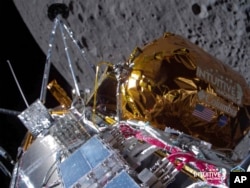A private spacecraft successfully lands on the surface of the moon and transmits a faint signal.
On Thursday, a privately-owned spacecraft from the United States successfully landed on the moon. However, the company stated that communication with the craft was limited.
Intuitive Machines, the company responsible for the lander, has not provided any recent updates on its condition.
The atmosphere in the company’s control center in Houston grew tense as controllers waited for a signal from the spacecraft, located 400,000 kilometers away. The signal finally arrived approximately 10 minutes later.
The mission director, Tim Crain, stated that they are assessing ways to improve the signal. However, they can confirm with certainty that their equipment has successfully reached the moon’s surface.
The lander, named Odysseus, lowered itself from an orbit close to the moon and directed itself towards the ground, looking for a suitable, level area amidst the numerous cliffs and craters near the southern pole.
The carefully planned landing of the lander was the first one for the United States since 1972, when Gene Cernan and Harrison Schmitt of Apollo 17 made the final footprints in the dusty surface.
On Wednesday, Odysseus successfully arrived at the moon after launching from Kennedy Space Center in Florida six days prior. The mission included carrying out NASA experiments.
The lander, made of carbon-fiber and titanium, had six legs and stood at a height of 4.3 meters. It was equipped with six experiments for NASA. The space agency provided $118 million to the company to construct and operate the lander, as part of their initiative to privatize moon deliveries before astronauts return in the near future.
In 1972, the United States ended its exploration of the moon with the completion of NASA’s Apollo program, which successfully landed 12 astronauts on its surface. Recently, Astrobotic Technology, a company based in Pittsburgh, attempted to continue this mission, but encountered a fuel leak that caused the lander to crash back to Earth and disintegrate in the atmosphere.
Intuitive Machines has become the first privately-owned company to achieve a successful landing on the moon.
Intuitive Machines aimed for a location 300 kilometers away from the south pole, at around 80 degrees latitude. This spot is closer to the pole than any other spacecraft has reached. The area is mostly flat, but there are boulders, hills, cliffs, and craters that may contain frozen water, making it an enticing destination. The lander was designed to select the safest spot near the Malapert A crater in real time.
The lander, powered by solar energy, was designed to function for seven days before the extended period of darkness on the moon.
In addition to conducting technology and navigation experiments for NASA, Intuitive Machines also leased space on the lander to Columbia Sportswear for testing their latest insulating jacket material. They also collaborated with sculptor Jeff Koons to include 125 miniature moon figurines on the mission and provided Embry-Riddle Aeronautical University with cameras to capture images of the lander’s descent.
Source: voanews.com




